The Discovery & Demonstration of the Minoan Calendar
by Dr. Jack Dempsey
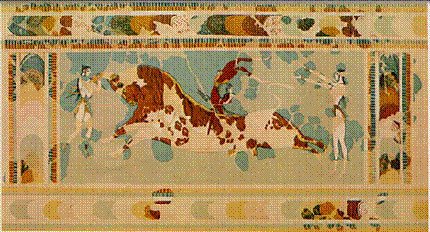
Imagine over 100 years of scientific digs into the foundations of Minoan Crete, and we knew nothing of how Minoan people reckoned the days of the year and the flow of time. No advanced and prosperous society could manage its agriculture, foreign trade and ritual life without a calendar. And yet, till now, little was known except that the 4-year timing of Olympic Games (first recorded in 776 BCE) was based in a much older calendar that began each year at Winter Solstice.
Herberger’s Theory of existence of the minoan calendar
This mystery began to be solved in 1972, when American scholar Dr. Charles F. Herberger published The Thread of Ariadne and revealed the Minoan calendar hiding in plain sight—in the patterns of features, colors and numbers in the decorative border of the famous Toreador or Bull-Leaping Fresco, from Knossos Labyrinth.
A review of Herberger’s evidences by Harvard University’s Dr. Alexander Marshack judged this discovery “valid and valuable,“ if further questions could be answered. Meanwhile I, studying Minoan Crete for 30 years, was ignorant of all this until I chanced to meet Charles Herberger in 2005.
Together we began to work to challenge and test this discovery. We used today’s computer-simulation astronomy programs, and much wider research (into Cretan ecology, astronomy, archaeology and tradition) in order to learn how consistent and demonstrable the patterns were within The Toreador Fresco, and how they compared across all other Minoan evidence. The goal was to create experiments by which people can discover the Minoan calendar for themselves.
The Calendar House and the Toreador Fresco in Knossos
The result is Calendar House: Secrets of Time, Life & Power in Ancient Crete’s Great Year. Here, allow me to share the good news and some essential basics of this discovery, and what it might mean to us who study and admire Minoan civilization—the longest continuous period of Western peace and progress on record.
How did the calendar come to light?
Herberger knew that the earliest solid clues concerned a cycle of the moon and sun that began each year at Winter Solstice. He also knew that Minoans were master-artisans. Why, then, did they leave so many “visual problems and broken patterns” in that elegant, uniquely complicated border around The Toreador Fresco? The problems and patterns drove Sir Arthur Evans himself to create special correction-notes about this fresco. Herberger started to carefully compare the two versions of it first-hand in the Heraklion and British Ashmolean Museums—and found his way through a labyrinth in a Labyirnth of clues and correlations.
One other tradition about Minoan time had come down to us. “King Minos” reigned for a set term or cycle of 8 or 9 years. Which was correct?
The answer turns out to be both. For the start of a year at Winter Solstice points to a fact of scientific astronomy. 8½ years is an ancient cycle of moon and sun, of lunar/solar time, that we can still see in the sky today. Our modern system uses fractions, leap-days and other tricks to bring a lunar year and solar cycle together in 365¼ days. As you’ll see, the Minoan way tracked a longer cycle using that 8½-year period—the roots of the later “Great Year” that governed Olympic Games. Herberger, then, had evidence and astronomy for examining problems and patterns in the fresco.
The two main patterns
His observed two main patterns in each vertical and horizontal row of the border: 62 colored crescent-shapes laid out in a 5-color sequence (orange, red, white, blue, black), and around those crescents, another pattern—16 rows of short black lines or “tracks,” the rows laid out in alternating orange and blue. The 16 rows make up 4 complete layers or circuits of the Fresco border. In Minoan Linear A script, a crescent signifies “moon,” and a short black “tick” is the numeral 1. Indeed, the two main patterns (62 colored crescents, and 390 tracks per circuit of the border) total close to a year of 5-phase moons and a 365-day solar year.
Why, though, did the border break its own established color-sequence and arrangement? And why had Minoan masters promised the eye a sharp rectangular border only to leave an awkward imbalance of “extra” tracks (in 3’s and 7’s) at the rectangle’s corners? The trick was to find by experiment the starting-point for counting through the fresco border’s features. Minoans read from left-to-right. When Herberger followed that one clue, an amazing series of patterns unfolded, with a logic that is fully answered by experiments and comparative evidences of many kinds.
The Minoan Great Year
The Minoan Great Year produces two signs in the actual sky that repeat every 8½ years: a New Crescent Moon at Winter Solstice (that is, New Year Day), followed six months later by a Full Moon at Summer Solstice. These unions, separations and returns (a known feature of Cretan folk dance) mark the observable unity of lunar/solar time and hence the “marriage of moon and sun” accomplished by all calendars.
Based in direct observation, these signs require no intervention of a priestly class to “tell the time.” Computer-simulation research shows that the phase of each moon along the 8 years of Solar Solstices is remarkably consistent over thousands of years. They could be learned, memorized and used in both practical and symbolic ways.
If we begin counting colored crescents on the fresco at the lower right corner (because Minoans read left-to-right), the orange crescent there might signify a New Crescent Moon at Winter Solstice/New Year Day. Count upward thirty black “tracks,” pass through a red (waxing), white (full) and blue (waning, shadow) phase, and there is a black or perhaps Dark Moon.
Continue on counting the colored crescents through one 5-phase month at a time, across the horizontal top and beyond, and indeed the fresco’s border completes a 12-moon year precisely (12 x 5 = 60)—with two points where its own broken color logic requires that we “leap” them and the sets of “extra” black tracks close by them.
The critical tests of Calendar House
The critical tests of Calendar House find that evidence from ecology to architecture confirm Herberger’s discovery. For example, in the Fresco’s two vertical rows lay the day-tracks of Crete’s normal 100-day Winter season of stormy rains. In the horizontal stretches, above and below the bull, are the longer seasons from Spring, to Summer Solstice, to Crete’s harvests of grapes and olives before the return of Winter rains. Snake of Winter, Bull of Spring, Lion of Summer—each sacred animal symbolized the sun in an annual phase important to the reliable success of food-production.
The Minoan economy ran on agriculture, and the skills that organized its long ages of plenty included the most timely religious ceremonial festivals. As a sample year unfolded in the border’s tracks, what emerged was a guiding logic of doublings within patterns that usefully pointed the annual “moveable feasts” most important to Minoan ceremonial life. A calendar must keep “sacred days” from “slipping backward” in time. Their arts and icons drew their power from observing, symbolizing and working with cycles of nature toward their farming society’s well-being.
Given Cretan traditions of farming and festival, the extra overhangs of tracks likely represented sacred celebration-times at key ecological points: 3 days at Spring and Autumn each, 7 days at Midsummer’s harvest of grains, and a 5-day New Year/Winter Festival, which was also the practice in Egypt. They total 25 solar days per year. Subtract 25 from the Fresco’s total of 390 tracks: the result is 365.
Signs of Minoan Calendar of the Throne of Minos in Knossos
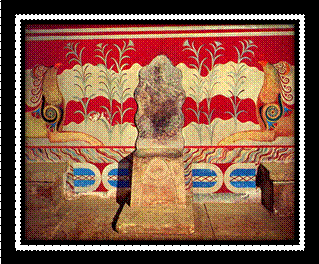
If we learn from The Labyrinth’s calendar to think like Minoans, what do we see with new eyes? First we understand the main features of the Throne of Knossos.
In each side of its white gypsum back-rest, we see 4 waves (8) and a 9th wave at the top. In its front is a crescent and a disc: a sign of moon and sun across the Minoan world.
The Calendar uses “doubling” patterns to teach its operation and mark the most-sacred days: the Throne rests within a second (doubled) chamber off the Labyrinth’s west court.
There is more to read in the symbols that surround this Throne, including the calendric problem of lunar/solar eclipses and the “shadow world,” of which the Throne’s flanking Gryphons are heralds and messengers.
Sign of Minoan Calendar in the Double Axes of Knossos Palace
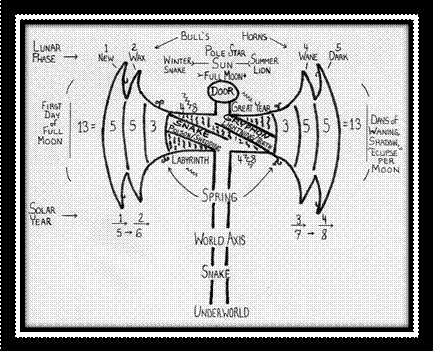
Without this logic that emerges in The Calendar Fresco, no one could explain the meaning of the Minoans’ sacred Double Axe or Labrys and its relation to The Labyrinth. Notice the tiny “X’s” at each side of the Throne.
Now, look below at this example of Labrys in its most high-ceremonial “doubled” form.
Count the points from left to right including the central one, and we see five lunar phases with Full Moon at the center. Count the lower points and we see four of them (the solar years) that double into a Great Year with the turning of the 4-year calendar and Labyrs itself.
Other features you can see suggest aspects of all three Minoan sacred beasts (Snake, Bull and Lion) as well as the mystical fourth one, Gryphon, guardian and guide of The Dead beyond “The Door” to the universe—which is at once the sun, the moon and the Pole Star.
Following the pattern of the Bull Leaping
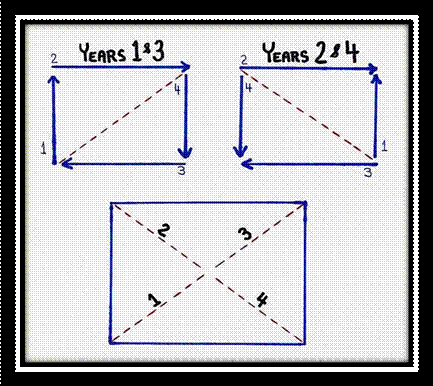
Notice also the pattern of our journey through the labyrinth of the Calendar.
When we learn to follow and “leap” at places in the fresco border, like the man leaping bull between female helpers, we must leap from one corner to another as a year turns.
When “Year 1” of a Great Year ends we find ourselves on the orange crescent at the bottom of the right vertical. There, we turn around, as in a labyrinth, and begin again having “doubled” or reversed our direction.
In two years, the leaps inscribe an X—a five-point form called quincunx common on Minoan pottery and seals, the shape of Labrys at the heart of The Calendar Fresco.
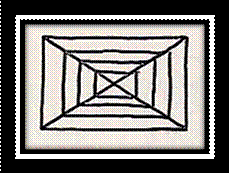
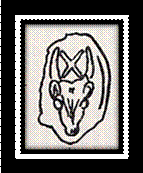
Because archaeology shows that they were normally stored “out of sight,” it seems likely that priestesses made dramatic ritual presentations or “ephiphanies” of Labrys to public view at least at these 2-year calendric intervals along the cycle of Great Year time. That showing-forth is in fact the focal point of the great Procession fresco from Knossos. By the time of Eleusis, a single ear of wheat had a similar function.
The Great Year is the link between Labrys and Labyrinth. Knossos, in all its control of daily production and trade and ceremony, was a “calendar house”—the center of the Minoans’ turning universe, a place for learning and celebration of the mysteries of time; their doorway from life to the next world. Hence as well the Minoans’ “pillar cults.” The Pillar of Life (like Egypt’s Djed Pillars) gave a center to Being, connecting The Labyrinth with both underworld and eternity beyond the Star Door.
The Minoans’ religious sense of the equality of moon and sun in the cosmic dance is reflected in their arts, in their traditions of gender-equality, and in what the Calendar suggests of answers to more old mysteries. Why, after all, were there limits on “King Minos” or Minoan leaders, when Pharaohs (for example) ruled for life?
Conclusions about the Minoan Calendar
Now we notice the bench-seats for many people close to the Knossos Throne: they are connected by the X or calendar-sign. The Gryphons are crowned with doubled crescent moons of orange and blue, the Calendar’s colors. Did community consent and sacred cycles of calendric time spell out terms of 2 years, 4 years, or the main 8½-year cycle for Minoan high priests and priestesses who sat there? Periodic ceremonial games would make compelling marriages between the cycles of nature and of politics. Could a “Minos” and/or Queen reign longer or lose their Throne’s renewal depending upon performance? Could deliberate Minoan limitations on political power help us to understand the long and peaceful nature of their development?
Why, too, did Minoans place a Bull-leaping scene at the heart of their calendar? Bull was the wildest monster they knew for representing nature and life. The male and female leapers’ relationships to it are celebratory, cooperative and competitive—all in a sacred and human context that is both “one day, today” and the circle of eternity. Has something of the Minoans’ long-successful wisdom about power itself come down to us in the spirit of today’s Olympic Games?
Last but not least for now, you’ll notice this remarkable thing in the border of The Toreador Fresco. In one-half of a year’s journey around the border, the mathematical relation between its black “1’s” and its colored lunar crescents is 22/7. That fraction today we call Pi—the infinite number that describes the relation of circle to circumference. The operation of the Calendar “doubles” this cosmic high-sign or “hello” toward eternity every year. If this fresco really is the Minoans’ calendar, something about their knowledge of nature and art led them to “square the circle” in an artifact that describes the hard numbers of a cycle beyond time.
So far Dr. Herberger and I have shared these findings with The Heraklion Archaeological Museum and a range of international scholars. Response has been promising, and time will tell more. These pages can only suggest the range of detailed consistent evidences studied in over 300 illustrations and experiments in the proofs of Calendar House. With all that The Calendar Fresco can teach us “directly” from the Minoans, we may soon begin to understand more secrets of their success.
Perhaps the historical destruction of Minoan Crete and The Labyrinth did not slay the monstrous man-eating Minotaur—but set one loose upon the world in what we have called, since that destruction, history.
About Dr Jack Dempsey
Dr. Jack Dempsey (Ph.D. Brown University) is author of “Ariadne’s Brother: A Novel on the Fall of Bronze Age Crete” (1996: Greek translation by Vicky Chatzopoulou).
Visit his collaborative website at Ancient Greece – Early America.com
Links
- Comments on the Minoan Calendar theory by experts on the Minoan civilisation
Was there a month called Lapathos?
The synodic period of the Moon is 29.53 days and for the Sun 365.25 days. These facts do not support the arguments and conclusions reported. For example a new Moon on a Winter Solstice would reappear about 3 years later to within about 0.1 day. A full Moon in 6 months does not match up either.